It’s pretty impressive how far budget optics have come. For the first in a series of budget optic reviews, I put the Primary Arms 4-14X40 ACSS DMR/HUD riflescope through its paces. The Chinese-made manufacturer has a cult following of loyal customers and as this scope proved, there are a lot of good reasons for that.
Let’s get the not-so-great part out of the way first. The optic’s clarity is mediocre. It’s not horrible, but it’s not amazing either.
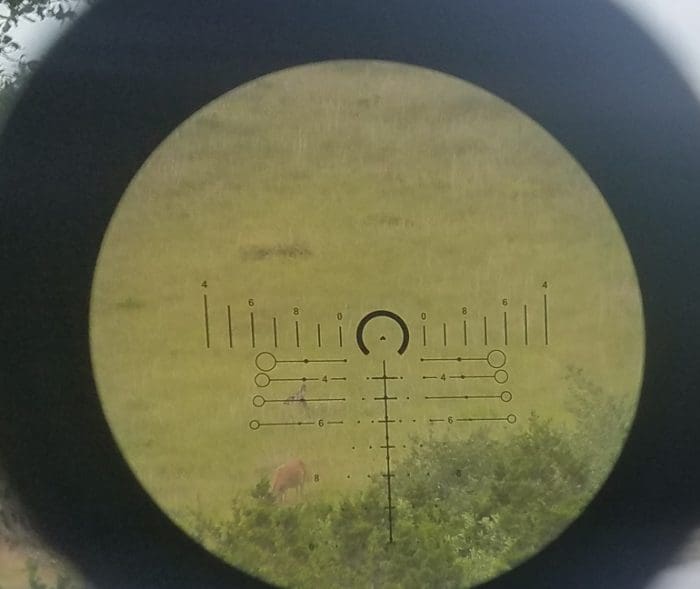
The photo above shows some White Tail does bedded down at 400 yards right at sunset, with the scope on full 14X magnification. That image quality is OK, and it’s certainly good enough to make the shot, but only for another 100 to 200 yards or so, not the entire magnification range. At long range, then the image becomes too fuzzy to take an ethical shot.
Now, if your target isn’t a living thing, something static, the target will probably seem clearer. But used on game or anything moving, it’s too difficult to get enough focus at long distances. That said, you have to ask yourself how often you’re really going to need to take a shot at game that’s more than 600 yards away.
What’s so impressive about the Primary Arms optics is the number of features a marksman gets for his money.
This is a front focal plane scope, meaning the image is on the first plane, not the second. The result is that the ffp scope reticle changes size in correlation with the magnification of the scope, allowing the user to estimate range and use the built-in holdovers at any magnification. On traditional second focal plane scopes, ranging is usually done only at the highest magnification.
A drawback to first focal plane scopes is that they’re usually more expensive, although not in this case. They also usually don’t have quite the precise level clarity on the reticle as second focal plane scopes do. On this scope, reticle clarity wasn’t an issue at all, as the overall clarity of the glass just wasn’t exceptional to begin with.
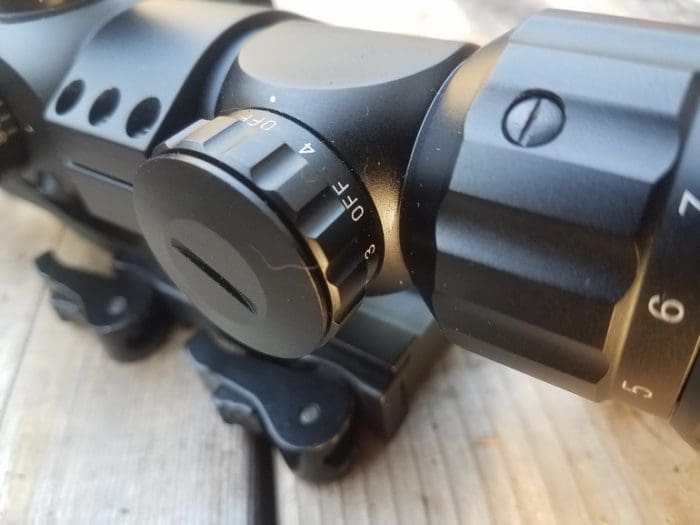
The illuminated ACSS-HUD-DMR reticle pops out well against a black target, and has off positions between each brightness level. I’ve seen that feature on more expensive optics, and it’s much appreciated. It is, however, too bright on any setting for use with IR night vision devices, as it simply floods the entire image.
On this model, both the windage and elevation knobs are in mils, with .10 mil adjustment clicks. It’s easy to move the brightly marked knobs, and they have very tactile and audible clicks to them to count a mil.
The parallax adjustment (and no, that’s not a focus knob) is easily finger adjustable and is capable of fine adjustments.
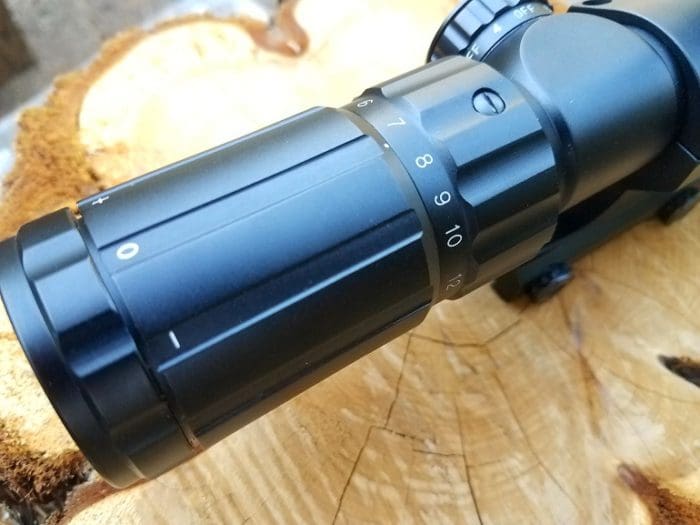
The magnification adjustment was done particularly well. It’s a single, large, knurled exposed turret that moves easy enough that I don’t have to change position at all to adjust it with one hand, yet stays in place once it’s set. I’ve seen a lot more expensive optics with much rougher movement. I found no distortion or lack of focus even at the highest magnification levels.
Be careful what mount you use on this scope. When I first tested the reliability of this scope, I had it mounted on a lightweight AR chambered in .458 SOCOM. It wouldn’t hold a precise zero between shots. Before I had to give the scope zero stars, I checked the mount to make sure that wasn’t the problem. In order to get proper eye relief without spanning the receiver and the hand guard rails, I needed a cantilever mount, and I had used one made by Atibal. I switched that one out and tried one made by Warne, as well as one from by Burris.
On the Warne and then Burris scope mounts, on several different guns, the problem disappeared. With those stronger mounts, the PA 4-14X44 held zero perfectly.
Some cantilever mounts can act like diving boards under recoil. If you’re using a heavier scope, (and this one is barely on the heavy side) the scope weight causes the mount to dip under recoil. That cantilever then springs back, violently shaking the mount and the glass in the optic. It likely won’t have that effect on a lighter-recoiling rifle, like a standard AR-15 shooting 5.56 NATO. The effect also doesn’t exist with traditional mounts without the cantilever.
This effect was verified by Bill Wilson of Wilson Combat. Wilson Combat used a slow-motion camera for product development. Bill told me that, with the slo-mo camera, he could watch cantilever mounts dip way down and then spring back up under recoil. The scopes inside the rings took a beating. The higher the recoil of the rifle, or the heavier the scope, the more of a beating the optic took.

Once I had the scope mounted in a more robust mount, I had no issues with it holding zero with any platform. To prove it was rock solid, I sat down with a Colt Competition AR-15 in a Caldwell Stinger shooting rest, all bagged up and stable. I put one full magazine through the rifle in one minute’s time, aiming at the exact same spot. All 30 rounds were within a 1.2 inches of each other.
No scope test would be complete without at least some semblance of a box test. I ran a very simple test at 100 yards. As the scope’s turrets are in Mil/Mil, I ran the test in centimeters. I shot a group, dialed what should have been 12cm left, shot a group, up 12cm, shot a group, right 12cm, shot a group, and back down 12cm. The last series of shots ended up right on top of the first series. Box checked.
I also simply shot a round, counted all the clicks to the right, then brought it back that number of clicks, shot, brought it left all the way and counted the clicks, brought it back, and shot. I ended up with 3 rounds within an inch.
All of this shooting was done with the scope mounted on top of a Colt Competition AR15 that has proven to shoot under 1MOA. All shooting was done in a Caldwell Stinger Shooting rest on a sturdy bench.

In short, the turrets track accurately throughout their entire length of travel.
This scope is equipped with the Primary Arms ACSS HUD DMR reticle. The point of the ACSS HUD DMR reticle is that you can use it to estimate both range and windage holds. The Primary Arms website proclaims “No math needed, no digging through the data book!”
No. Not just no, hell no. Maybe even Helz Naw! Never give up your data book.
Ballistic reticles like the ACSS — and this is a good one — provide the user with built-in holdovers for elevation and windage. But with a pretty massive caveat. They are good for a specific bullet, at a specific speed, under specific environmental conditions.
This PA ACSS HUD DMR will work for a few different rounds, all detailed in the manual. For instance, the .308 reticle will work for .308 loads that are 175gr SMK at 2550 to 2600 fps with a 50-yard zero, or a 168gr SMK at 2,700fps with a 100 yard zero or 2,600 fps with a 200 yard zero. The ACSS reticle also lines up with a few .223/5.56 NATO ammo loads as well as one 6.5 Grendel load.
Not shooting one of those loads? Then the patented ACSS reticle’s features won’t really work for you.
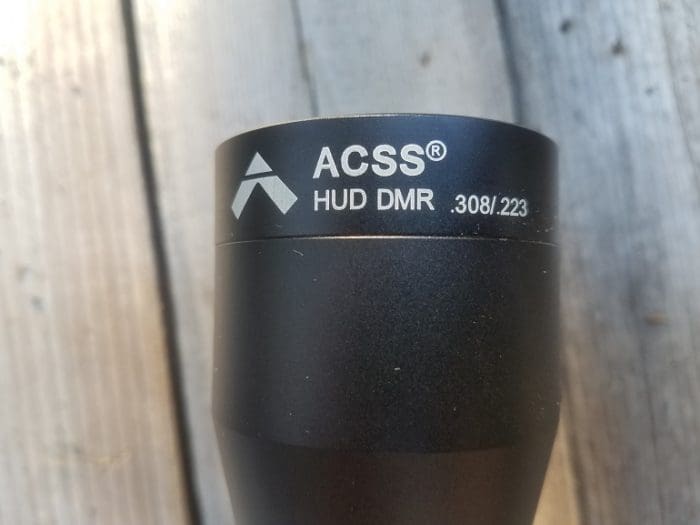
I was able to verify that, out to 600 yards, several of the listed loads do in fact line up. They may work even farther, but past 600 yards I was having trouble with the wind on a 1.2-MOA target.
But wait, aren’t there wind holds too? Yes, and they’re good for 5mph and 10mph wind. But I found this to be of little value with the target size I was shooting. For instance, at 600 yards, the recommended 77 grain Hornady A-Max round moving at 2800 fps (20″ barrel) hits at .9 mil or 19.8 inches of windage. What if the wind is just 3mph more? There is no 8 mph cross-hair hold, and at 8 mph it’s 1.5 mils of wind, or 31.8 inches off the center of the target. It’s about the same for the .308 168-grain SMK round at 2700 fps.
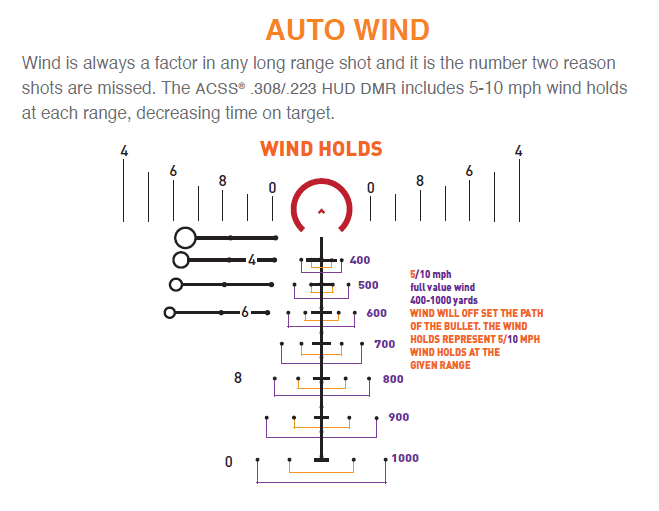
That may seem like a lot, and for many game animals that really is too much of a discrepancy to just use the wind holds to reliably shoot. After all, that’s a 12-inch difference at 600 yards, larger than the breadbasket of common game animals. But it does fit right inside a human silhouette, and it works for heart/lung sized targets if you’re at the first wind hold, the 400 yard mark. It also works past the 600 yard mark, as long as you’re considering an area target, not a human sized or smaller target.
Of course, if you get lucky, and the wind is either 5mph or 10mph, using the listed rounds, under the right conditions, it works just perfectly.
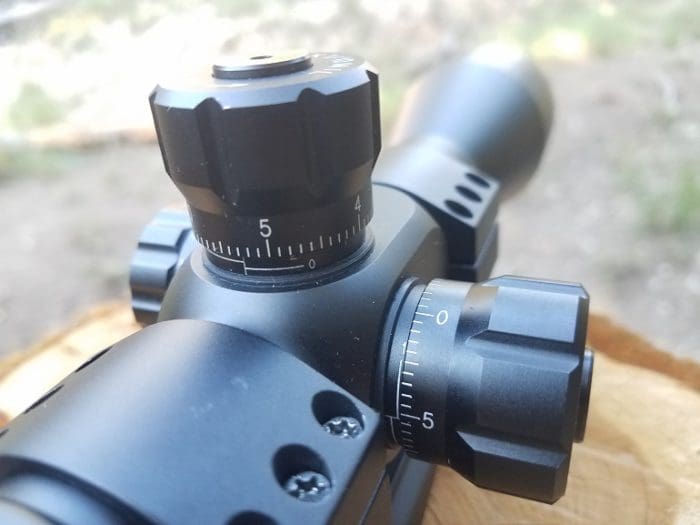
Overall, I wouldn’t use this ffp riflescope reticle. There is a lot of information in the view through the scope, and it’s too much for me to think about. I’d rather go back to lasing the target and dialing my bullet drop corrections based on Data on Prior Engagements/Direct Observation of Prior Engagements (DOPE). Or based on my own trued ballistic software.
It was much faster for me to just use the scope in the traditional manner, dialing corrections. If I used this scope with a dedicated round and shot it all the time, that would be different.
Overall, Primary Arms is giving you a lot of features for the money. No, the glass doesn’t come close to Schmidt & Bender, US Optics, or even the Vortex Viper PST line. But the PA 4-14 ACSS HUD/DMR costs a small fraction of those scopes with an MSRP of only $279.99.

Specifications: Primary Arms 4-14X44 ACSS HUD/DMR Riflescope
Battery Type: CR2032 3V Lithium Coin
Turret Style: Turrets
Click Value: 0.1 Mil
Exit Pupil Diameter: Low: 11.20 mm/High: 3.30 mm
Eye Relief: Low: 3.22 in/High: 3.14 in
Field of View 100: Low: 27.20 ft/High: 7.85 ft
Focal Plane: First Focal Plane
Illuminated Reticle, multiple brightness settings, center chevron
Length: 12.9 in
Finish: Matte black
Maximum Magnification: 14
Minimum Magnification: 4
Night Vision Compatible: Non-Compatible
Objective Diameter: 44mm
Reticle: ACSS HUD DMR 5.56 NATO
Reticle Type: BDC
Total Elevation Adjustment: 30 Mils
Total Windage Adjustment: 30 Mils
Tube Diameter: 30mm
Extras: Waterproof, shockproof, and fog resistant
MSRP: $279.99
Ratings (out of five stars):
Glass quality and clarity * *
Great glass still costs good money, and this is one feature — probably the only feature — that Primary Arms couldn’t squeeze into this scope at this price point. Leupold and Vortex Optics shooters will be disappointed.
Reliability * * * *
With a sturdy mount, that reticle won’t budge. Just make sure you have a strong mount if you’re going to use a cantilever mount on a stout-recoiling rifle.
Knob and Turret Quality * * * *
Good tactile and audible feedback with sure and easy movement.
Overall * * *
Glass clarity isn’t anything special, but everything else is very good. Primary Arms continues to prove that budget optics can offer you a lot of performance for your money, and you might want it on your wish list.





Dimitry really has his sh!t together. Tier 1 optics cost at a minimum 3 times this and can go up to 10 times. He invented the ACSS reticle which he then licensed to other brands. And for those looking for high end glass quality, primary arms has a premium line, too. And for those wondering, I have no affiliation with him or the company, other than being a customer.
So it’s perfect for a chicom QBU88? US gun owners and some lazy go to China “manufacturer” directly finances the PLA’s R&D. Ain’t that GREAT. Our troops will one day appreciate it.
Yes, it IS great that the Chinese are helping to better arm and train Americans, and help an American company make a profit at the same time.
Military looking, black, full semi auto sniper thingie. Likely illegal in commie kalifornia.
If you wanted to talk about game animals you should have gone with the acss orion. The acss dmr is meant for minute of badguy shooting. Also you fail to note that like many competitors they offer multiple reticle options including a milling and moa.
“you should have gone with the acss orion”
That’s not how this works. They send me items to review, I review them, and I can only the review the actual item I have, not the items I don’t have.
You’ve completely missed the point then.
“Not shooting one of those loads? Then the reticle’s features won’t really work for you.”
Nonsense!!!!!!!!!!!
Measure your load’s MV using a magnetospeed chrono. Know the manufacturer, the bullet and the load and use the Vortex LRBC (Long-Range Ballistic Calculator, currently offline until July 15th for upgrades). You can also input environmental information about the site your going to be shooting from and even information like twist rate of your barrel.
Then the calculator will tell you what yardage / meters applies to each elevation hashmark. What’s the difference if the third down elevation hashmark is 300 yards or 321 yards. The important part is that you know what it’s value would be with your load.
WITH THE ACSS RETICLE YOU CAN USE ANY LOAD ACCEPTED BY YOUR RIFLE IN ITS CALIBER. I own a copy of the exact scope reviewed in this article and with the LRBC it works magnificantly, 1st try, 1st round hits at 600 yards on steel.
Oh, and Vortex’s LRBC is not the only Retical -Ballistic matching calculator out there for free. There are many and even one that can be run on your cell phone.
Meant June 15th.
You are absolutely correct. You can get your ballistic software, your environmental information, your cartridge information, and your data book, and make the ACSS reticle act just like any traditional Mil Dot or MOA reticle.
See my point?
Do now that we’re in agreement that with a little work the scope’s reticle elevation and even windage indicators can be “assigned” to any load that can be safely fired from the rifle, be it AR-15 or, as in my case AR-10.
So, ammunition that PA didn’t assign to the rifle, ammunition that’s wildcat or hand loaded ammunition to give the best accuracy from the specific rifle under consideration and even multiple loads carried for different purposes could be easily built into a data book and used.
The scope’s not the hindrance. It can do just about anything if the shooter’s willing to do some math and some measurements of his rig.
Oh, last thought…I really appreciate your having pointed out the importance of a solid mount if a cantilever mount is to be used. Luckily, I have used both the Warne and the Burris mounts on my two .308s and, just as you suggest, they hold zero impeccably. I’m about to try the LaRue QD mount to see if it works as well.
So, I would have never known there might be a problem with lesser mounts. And, thanks to you and your colleagues, now I know the mechanism behind the won’t hold zero problems too.
Thanks again.
Mr. Walters, there’s a review on this pending, but since you are going to go shopping, here’s a spoiler.
The Warne X-Skel Cantilever mount is the best one I can find on the market. Bill Wilson found the exact same thing to be true using his slow motion camera. Considering its cost, it’s the cantilever mount I’m buying. In fact, I already bought 2.
https://shop.brownells.com/optics-mounting/rings-mounts-amp-bases/mount-sets/x-skel-mount-30mm-black-sku947000384-84828-167790.aspx?cm_mmc=PPC-_-Itwine-_-Bing-_-947-000-384&msclkid=242153d4797e15f2b5ea08d1aa2b7346
This scope was set up around the 223 and the 308, also some 6.5 loads. When used with the correct load the BDC is pretty awesome, it’s well thought out. I have no idea why you would review this scope by putting it on a 458 SOCOM, that makes no sense at all. Also throwing around a big name to down a mount is kinda just name dropping and to me discredits the the entire article. I have a Vortex Viper PST and the glass in this is every bit as good, if you don’t think so have your eyes checked. All in all I’m not impressed by the article, but owning the scope is impressive.
Great info, JW.
I’ll look into it tomorrow morning. Right now, I’ve some spectacular pork ribs and fresh veggies from my garden that has captured my imagination (and salivary glands).
But before I go, it was my pleasure corresponding with you. And, thanks for the great information you’ve conveyed to me and readers of TTAG.
Please call me Wayne (we seem to share the same middle name) as all my friends do.
It’s nice to read reviews like this. In all my years reading Gun magazines I’ve never seen a review where they said “the glass isn’t great, but for $300 this is a pretty good scope”. Usually you only read glowing reviews.
So far I’ve purchased 2 PA scopes, a 2.5x and a 4x ACSS prism sight. Both are pretty good for the money and the glass seems clear, even when compared to my TA11. I’m not a very experienced scope shooter though and have had problems with the groups moving around on the target at 100 and 200 yards as my eye position changes between different positions.
The information about the cantilever mounts is appreciated. Its not often I learn something new like that. I want to build a DMR type AR15 in the near future and will make sure I get a sturdy mount so I don’t run into any problems.
Dear Grant,
Both eye relief and head position are important to achieving a reproducible sight picture with either irons or optics. And, if you’re using an adjustable magnification scope often you also need to concern yourself with parallax (the scope featured her has an adjustment for parallax).
I was sort of an irons sort of guy too having come of age in the Marines in 1972 – almost 1980 and never had seen a rifle scope but on someone else’s sniper rifle.
Just keep reading and practicing both dry and live firing. It’ll come to you faster than you think.
Until
All I can do here is shake my head and laugh.
I’m sorry I can’t imagine why a .458 SOCOM load would shake an optic that is designed for a .308 max cartridge and possibly rattle it. I wouldn’t even use a Leupold with that round.
As for not using the Orion reticle like the other user suggested, well that isn’t how this works. You should know the equipment that you are using and what it is designated for. That optic is designed for quick DMR style shooting not hunting. You can hunt with it. I don’t think a 600 yard shot would be ethical but hey some people can make that shot and props to them.
As for shooting 1.2MOA @ 600yd.
Buddy Let me tell you about this fish I caught.
Using dope for hunting? Really? I don’t know anyone that I have ever hunted with that pulls out a heavy thumbed DOPE card and does mil relation calculations on that deer they only see for a few seconds. I guess you could. Or you could just use the built in MIL hashes of this optic.
As for the 8mph wind hold that is between the 5-10 hold off points. Common Core seems to be affecting everyone these days. Might want to pull out that old Leupold Mark 4 and dust off the cobwebs with a light breeze.
It is also funny some of the reticles coming from this company are being put into ACOG’s however those aren’t made in China well at least not that I know of.
I give this review 4/10. The tracking box is a +1 cause you tried.
If you don’t use a dope card or a ballistic app when you hunt, you might want to give it a try. Try a sector sketch with holdovers at key points as well. You might make better shots, and you might enjoy your hunt more. Until then, acknowledging that you in adequately prepare explains why you think 1.2 MOA is impossible.
I’d Be willing to bet ole’ Sam did a different kind of hunting. The kind while in uniform, the prey walked on 2 legs and when making the shot really counted.
I bet not. I spent more than a couple of years doing that kind of hunting myself.
One of the first things you learn is the value of a DOPE card and a sector sketch.
Actually, I did.
It is one of the reasons I specifically mentioned “deer” as a deer not a euphemism for something else. Also why me saying that I “know of no one who hunts deer that use a DOPE card” or a Sector Sketch, doubtful most of the readers here do the same.
With your “experience” you should know roughly where a 8 mile per hour hold is without the need for it to be marked, should being subjective.
What is of disappointment is your failure, within this review, to even mention the built in auto range mechanics of the optic. I think you just don’t like it because it is made in China so you threw together a piece and hit publish. It isn’t a S&Bender nor is it a Burris(Philippines manufactured).
It could be me in “misunderstanding” the entirety of this piece and its clever puns. Looking forward to future articles.
I own the mil/mil version of this optic. It’s been quite adequate for everything I’ve used it for – shooting 95% within 300 yards, and in the DMR role in informal field problems. The reticle is also better than the ACSS HUD…the ACSS reticle (or any BDC, for that matter) is not a match for a high-magnification optic.
That said, the glass clarity and light transmission certainly leaves a bit to be desired, particularly at high magnification settings. I think I only paid $230 for mine, so mediocre glass on an otherwise reliable and practical optic isn’t really a big deal. For what it’s worth, I’ve been much more impressed with the optical clarity of the fixed-power prism optics from PA. Both the 2.5x and 3x are about 80% as good as a TA31, in my estimation. Even the low-light performance is impressive.
Have you reviewed any Muellers? I have a couple, like them both. Also Chinese made, under $300 and a loyal cult following (well, a few years ago anyways, haven’t checked lately). Thanks
JW, thanks for the review! As one who’s asked before for reviews of optics that aren’t at the top of the line, I especially appreciate it.
The info re cantilever mounts is both interesting and concerning. Do you have a link to Bill Wilson’s test results? (Or is this the “pending” you mentioned earlier!) Or, heard anything about Aero Precision’s ultralight mounts? I love their “clamping” design but am now wondering about their stiffness… Thanks!
I’ve used a PA4-14xffp308 and liked it. Other mil-dots from a variety of makers do have better glass clarity, imo. I prefer a red dot mounted at 45 degrees for inside 100 yards, with my first optical zero at 100 yards. The 223 reticle in another scope is often pretty dang close with many loads.
Ok gents I just tried this reticle on the slx 3-18. I shoot with some of the best match people in the world. I had one of the world champions spotting me out to 1000 yards yesterday using a 175 smk at 2600 fps… zero was half minute on a 5k dollar rifle. The bullet would drop off at around 450 yards… so a 50 dollar walmart scope could do that far. As for longer ranges; it just couldn’t hit the broad side of a barn. At 650 yards is was shooting three bus lengths off. So as far as a drop table on the HUD DMR… it really sucks and not worth the money. I’d say the scope is worth about half what I paid for it to be realistic. If nightforce or trijicon came out with a similar reticle… I would buy it… primary arms well not so much. This is the first scope I bought from here and it will be the last. No sense of throwing money away while sending them downrange. To be fair some genton the internet said he shot 1000 and it was dead on thru all travel… but he zero’d at 50 yards; before i do my review I will try this. Honestly, I believe anything chinese should be cut loose from our country with few exceptions. No I’m not anti communist; just anti chinese. Russia is fine for the most part if you understand them. I give this scope 2 stars at best out of 5. They should have never listed it as a 18 power scope. This false advertising the commie way. It is however a good 200 hundred dollar scope up to 15 power if you understand the light transmission suck in comparison to hd glass from reputable companies in the USA. End of rant.